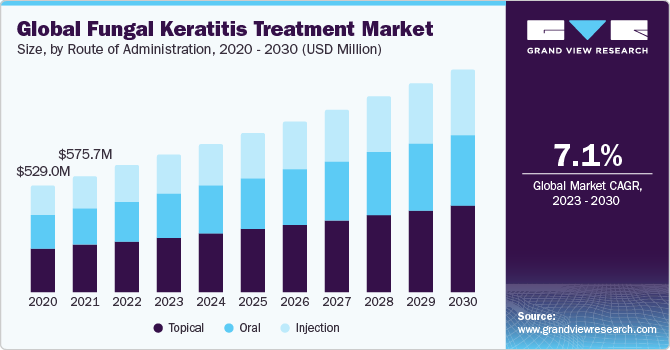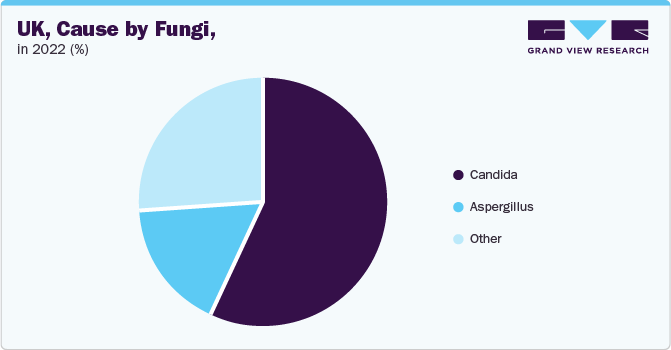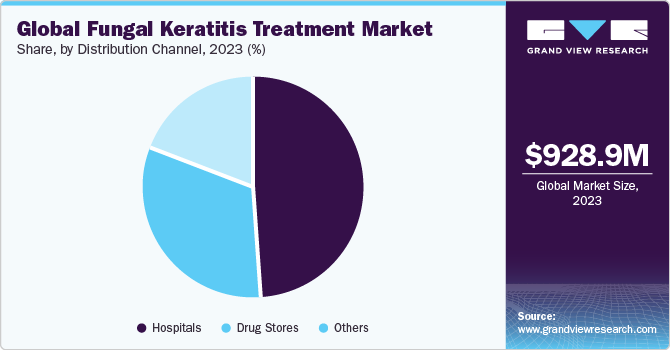- Home
- »
- Pharmaceuticals
- »
-
Fungal Keratitis Treatment Market Size & Share Report, 2030GVR Report cover
![Fungal Keratitis Treatment Market Size, Share & Trends Report]()
Fungal Keratitis Treatment Market Size, Share & Trends Analysis Report By Type (Antiviral Drugs, Antihistamines, Vaccines, Other), By Distribution Channel, By Region, And Segment Forecasts, 2024 - 2030
- Report ID: GVR-4-68040-193-6
- Number of Report Pages: 100
- Format: PDF, Horizon Databook
- Historical Range: 2018 - 2021
- Forecast Period: 2023 - 2030
- Industry: Healthcare
Fungal Keratitis Treatment Market Trends
The global fungal keratitis treatment market size was valued at USD 928.9 million in 2023 and is expected to grow at a compound annual growth rate (CAGR) of 7.09% from 2024 to 2030. Fungal keratitis, an infection affecting the cornea, the transparent covering over the eye’s-colored portion, is induced by various fungi. Among them are Fusarium species, Aspergillus species, and Candida species. The rising prevalence of fungal keratitis cases globally contributes to the demand for effective treatment options. Advances in diagnostic technologies enhance the early detection of fungal keratitis, enabling timely intervention and treatment.

According to an article published by the National Library of Medicine in March 2023, the demand for improved diagnostic methods for fungal keratitis was driven by the limitations of current techniques, such as the cultural method and direct microscopy with staining, which may need revision for timely and accurate identification. The increasing morbidity and the growing medical, social, and economic significance of this condition have spurred the search for new diagnostic technologies. In this context, PCR diagnostic methods have gained prominence, becoming routine practices in some medical fields. PCR diagnosis is considered promising for identifying fungal keratitis due to its quick results within 4 hours, high sensitivity of 94%, and the ability to identify the species of the pathogenic fungus.
Furthermore, according to the MDPI article published in March 2021, fungal keratitis poses a significant threat to vision, resulting from corneal infection by filamentous yeasts or fungi. It constitutes most microbial keratitis cases in tropical regions and low to middle-income countries. Filamentous fungi contribute significantly to the disease burden, particularly Fusarium spp., aspergilli, and dematiaceous fungi. Trauma, often involving organic, plant-based material, stands as the primary risk factor in these regions. However, contact lens use in developed nations is a common risk factor, leading to global outbreaks of Fusarium keratitis. The estimated global incidence of fungal keratitis surpassed 1 million cases in 2020, exhibiting considerable geographical variation, ranging from less than 1% of microbial keratitis cases in some European countries to over 80% in certain parts of South and Southeast Asia.
Route of Administration Insights
The topical route of administration segment gained the maximum market share in 2023. However, the oral route of administration segment is expected to grow at the fastest CAGR over the forecast period. An article from the American Academy of Ophthalmology in April 2023 highlighted that in Brazil, prevalent isolates for fungal keratitis included Aspergillus spp at 10.5%, Fusarium spp at 67%, and Candida spp at 10%. Additionally, approximately 40% of these infections were linked to traumatic events. Consequently, given considerations such as convenience, compliance, efficacy, and safety, the oral route of administration holds significance in the fungal keratitis treatment market.

Distribution Channel Insights
Based on the distribution channel, the fungal keratitis treatment market is segmented into hospitals, drug stores, and others. The hospital segment dominated the fungal keratitis treatment market in 2023, serving as a centralized and specialized point for the procurement and distribution of antifungal medications and related treatments. Hospitals play a crucial role in managing fungal keratitis cases, providing a comprehensive range of medical services, including diagnosis, prescription, and administration of medications. The hospital setting ensures that patients have access to necessary pharmaceuticals, including antifungal drugs, and receive appropriate medical care for fungal keratitis.

Regional Insights
North America dominated the market in 2023. However, the Asia Pacific region is expected to experience the fastest growth during the forecast period. According to the American Academy of Ophthalmology, the prevalence of fungal keratitis as a leading factor in corneal ulcers is a significant driver for the fungal keratitis treatment market. In regions such as South India, Bangladesh, Ghana, and Nepal, fungal keratitis accounts for a substantial portion of corneal ulcers. Hence, its rising prevalence in the APAC region is anticipated to make a significant contribution to the fungal keratitis market.
Key Fungal Keratitis Treatment Company Insights
Key players operating in the market are Alvogen, Bausch Health, Gilead Biosciences, Inc., Glenmark Pharmaceuticals, Leadiant Biosciences, Merck & Co. Inc., Aurolab, Eyevance Pharmaceuticals LLC, Novo Holdings A/S (Xellia Pharmaceuticals), and Pfizer Inc. The market participants are working towards new product development, M&A activities, and other strategic alliances to gain new market avenues.
Share this report with your colleague or friend.
![gvr icn]()
NEED A CUSTOM REPORT?
We can customize every report - free of charge - including purchasing stand-alone sections or country-level reports, as well as offer affordable discounts for start-ups & universities. Contact us now
![Certified Icon]()
We are GDPR and CCPA compliant! Your transaction & personal information is safe and secure. For more details, please read our privacy policy.
We are committed towards customer satisfaction, and quality service.
"The quality of research they have done for us has been excellent."





